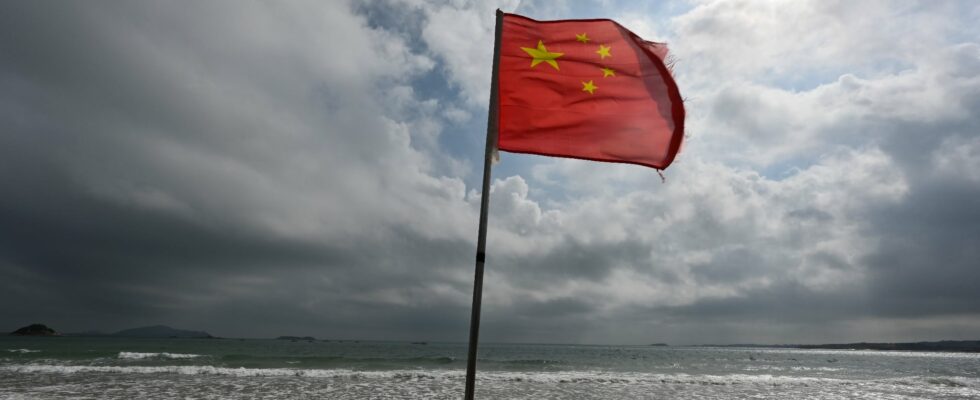2024 marked a clear intensification of the pressure put by China on Taiwan, between ever-increasing flights over the island by military planes from Beijing’s army, large-scale exercises and threatening declarations. 2025 already seems to be following the same path, according to the declarations of Xi Jinping during his wishes to the Chinese people for the new year. “The Chinese on both sides of the Taiwan Strait are one family. No one can sever our blood ties and no one can stop the historic trend of reunification of the motherland,” he chanted again at the national television.
But beyond words, actions and projects bear witness to China’s ever-increasing preparation for such an operation. The specialized media Naval News thus reports the construction of all new ships. And more particularly large barges, designed especially for an amphibious assault on the neighboring island. At the front of these, we would find a bridge more than 120 meters long, allowing the deployment on the ground of tanks or motorized vehicles, but also of ground troops. At the rear, a platform allows other ships to dock and unload their contents.
The inspiration for these ships seems obvious: the Mulburry ports, during the Allied landings on the coast of Normandy in 1944. These allowed the Allies to overcome the extreme difficulty of conquering one of the large deep-water ports held by the German forces. The project was then launched to assemble an artificial port on much less defended beaches, and to use it as an area for unloading equipment and supplies. This innovation was particularly successful in the Normandy commune of Arromanches, allowing the British and American forces to disembark in one hundred days nearly 2,500,000 men, 500,000 vehicles and 4,000,000 tons of equipment, i.e. a significant portion of the success of the landing.
Open new landing sites
The context and scope of the Chinese project are obviously nothing comparable. But the source of inspiration is there. In the Daily TelegraphLyle Goldstein, professor at the Watson Institute, believes that there is “clear evidence” that China “studied the Mulburry project and other aspects of the Normandy landings with considerable care”. And this new project could well transform the way Taiwan must defend its soil.
While until now, the most studied scenario of an invasion of its territory by China was based on the takeover of one of the large heavily defended ports or part of the dozen or so beaches suitable for a large attack from the sea, these artificial ports would make it possible to increase the number of potential deployment locations. These barges, with a very wide reach, would thus make it possible to bypass certain terrain not very conducive to the landing of heavy vehicles, such as sandy or rocky beaches, and to directly reach coastal roads or firmer ground.
A comment echoed by Emma Salisbury, researcher specializing in naval issues for the Council on Geostrategy think tank with Naval News: “Any invasion of Taiwan from the mainland would require a large number of ships to quickly transport personnel and equipment across the strait, especially land assets such as armored vehicles.” A problem that could be resolved by the creation of these large barges, which, if established quickly enough, could quickly catch the Taiwanese defense by surprise and open breaches at various points.
“A very easy target”
Although these barges could expand Chinese strategic possibilities, they do not, however, alone transform the balance of power. With a fairly simple reason: we are no longer in 1944. To be able to lead the deployment of these artificial ports, China will first have to establish clear air and maritime domination. And even then, these ships would remain extremely susceptible to anti-ship missile or drone fire. These ships “should not be taken to an actively contested landing site, because they would be a very easy target”, said the Daily Telegraph Eric Gomez, a researcher at the Cato Institute, an international security think tank. Especially since we have seen in the most recent conflicts, notably between Ukraine and Russia in the Black Sea, the extent to which even very inexpensive weapons could wreak havoc on ships. Suffice to say that Taiwan, heavily equipped by the United States, should a priori be able to inflict heavy losses on the Chinese fleet and these new barges.
But even in the scenario where the Chinese army succeeds in docking some of its ships and bringing armored vehicles and ground troops onto the island, the hardest part would still remain to be done, as told by The Express in June 2024. Beijing’s troops should then advance in mountainous portions that are difficult to pass, or even in highly populated urban areas, making progress relatively difficult. All this, with the prospect of greatly increased American military support, while the United States has in principle been committed since 1979 to defending the integrity of the island. But here again, as in so many other points of tension in the world, we find the same uncertainty: Donald Trump, and his return to the White House.
